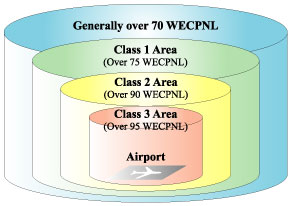 |
|
 |
 |
Measures for the environment surrounding airports
|
 |
Due to the need to meet the increasing demand for air transport, the number of jets or jumbo jet aircraft and the frequency of flights have increased. Under these circumstances, the impact of aircraft noise on the areas surrounding airports has become an important issue. In order to resolve this issue, the following noise abatement measures have been carried out in Japan : 1) adaptation to the standards for aircraft noise, 2) introduction of low noise generating equipment, 3) adjustment of the number of flights, and 4) establishment of operational systems to reduce noise, as well as improvements in the airport structure and location, such as the offshore construction of airports, in order to reduce the impact of noise on areas surrounding airports.
In addition, concerning areas that are still impacted in spite of these measures, the following measures are being implemented on the basis of the Aircraft Noise Prevention Law : 1) assistance towards the soundproof construction of houses, schools and hospitals, 2) compensation for relocation, and 3) construction of green tract zones etc..
|
 |
 |
(Reference) Measurement system
Areas generally over 70:
Assistance for the soundproof construction of educational facilities
Class 1 Area (over 75):
Assistance for the soundproof construction of houses
Class 2 Area (over 90):
Compensation for the relocation of buildings out of the area
Class 3 Area (over 95):
Construction of green tract buffer zones |
Measures for creating environment-friendly airports
In airports, due to various activities by airport businesses and their complex operation, it is essential that all airport businesses have a proper understanding of and share the environmental issues in order to carry out the measures for them.
To promote these activities, airport administrators together with all airport businesses prepare the Airport Environmental Plan on a voluntary basis and become involved in the environmental strategies to conserve energy, promote recycling and embrace environmental creation etc..
|
 |
Measures to cope with global warming
In the Conference of the Parties to the United Nations Framework Convention on Climate Change, the Kyoto Protocol was adopted in 1997 (COP3), and enacted in February 2005. In the Protocol, Japan committed 6% reduction of greenhouse-gas emissions by 2008-2012 period compared to year 1990 level, and is taking measures against global warming in accordance with “the Plan for Achieving the Targets of Kyoto Protocol (approved by the Cabinet in April 2005)”. As part of concrete efforts in civil aviation sector in Japan, the following measures for the reduction of greenhouse-gas emissions have been implemented : 1) promotion of the replacement of current aircraft with new types of aircraft with improved fuel efficiency, and 2) improvements in operational efficiency through the upgrading of air traffic control systems (development of RNAV, higher categorization of ILS, and introduction of next-generation air-navigation systems). |
|












